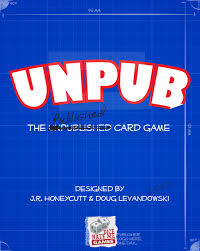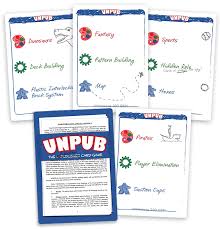Learning Mechanics Using the Game Unpub
|
Getting my students to learn all the different mechanics has always been somewhat problematic for me. You would think that I could have come up with some sort of game to have them learn them, right? With 25ish mechanics, more if they got into the more unusual ones, I always tilted towards a straightforward, didactic, here's the content kind of approach so they would learn them. I used a quiz, too. There are benefits to using such a direct approach, but I wanted to have them learn the mechanics and have more fun with it from a game design perspective.
I picked up a copy of Unpub: The Unpublished Card Game at Stonemaier Games' Design Day from the swap table. I figured it was something I could use. I looked at it, an um, yes! The game's rules are simple. Players take on roles or game designer or publisher, and game designers pitch their games to the publisher using a theme, a mechanic, and a type of components (or two of the three). The rules as they are didn't necessarily fit my needs, but I could adapt them to work for us, and they did! I didn't care about the components, and not all of the mechanics we use, and some we don't, were on the cards. So I used the blank cards to add more mechanics and themes, and crossed out some that we don't use (hellooooo player elimination). I made my own version of UnPub cards that have more mechanics and themes with no components listed on the cards. I made a super simple document for them to record their ideas: UnPub-Esque Mechanics Brainstorming. See my mechanics packet for the specific mechanics that I use.) I then have students use the cards to create game concepts, and we shared them. Here's more details on what I did. |
Needed materials:
A copy of Unpub
Sharpies (to write on cards)
Students need paper or index cards, something to write with.
Each student should also have their game mechanics packet.
Process:
When we finished, I felt like kids had learned way more about the mechanics because of the time spent discussing them, both for their game concepts and for others. Woo hoo!
A copy of Unpub
Sharpies (to write on cards)
Students need paper or index cards, something to write with.
Each student should also have their game mechanics packet.
Process:
- Explain that we are going to play some games to help them learn the mechanics more in-depth, and to brainstorm ideas for game concepts.
- Pair students with a partner, or let them choose.
- Give each students some Unpub cards, divided up evenly between the students (two or three per pair, at least). Explain the three symbols and what they mean: palette for theme, gear for mechanics, and meeple for component.
- Each round, students will create a game concept using a mechanic and theme, and present it to the class. We played a number of different ways, there are many different ways you can riff on this. Note, the different ways that cards were chosen were done in order to show them some different options on card drafting. Students were required to read about the mechanic(s) in their packet as they were working, so their descriptions would be accurate.
- Choose one mechanic and one theme, and create a game concept.
- Choose two mechanics and one theme...
- Give the team to your left a card to use for its mechanic, and the team to your right a card to use for its theme (or vice versa).
- Give each team a stack of Unpub cards, the same per team. Using a card drafting system, each team draws a card, then passes the remaining cards to the left. They draw another card, pass the remainder, and continue until they have no more cards to pass. From these, cards, they choose a mechanic and a theme, and make a game.
- Give each team a stack of Unpub cards. They choose a theme and a mechanic that their group to the left MUST use. (They may use the same card or different cards for their theme and mechanic.)
- Give each pair three blank index cards. Tell them to create fake game names. Then, gather them, shuffle them, pass them out the students. Pass out the Unpub evenly to each group of students. Each pair chooses one fake game title, and then creates three different games using one unique mechanic for each.
- I sorted out initially the cards with mechanics I don't allow students to use. I marked those with a big dot with a sharpie. I then took those cards, and gave each group some. (This way they see new themes.) Each group had to create a mashup of TWO theme cards, and chose one mechanic from their packet to create a game concept.
- Mechanics charades. Since they involve choices, they tend to be fairly easy to act out.
- After each group presented, no matter the method, students closed their eyes and voted for the game they most wanted to play (not their own). I announced the winner, and we continued with the next round.
- At the end of each class, I collected each group's papers. For assessment, you can check that they described their mechanics accurately.
When we finished, I felt like kids had learned way more about the mechanics because of the time spent discussing them, both for their game concepts and for others. Woo hoo!


